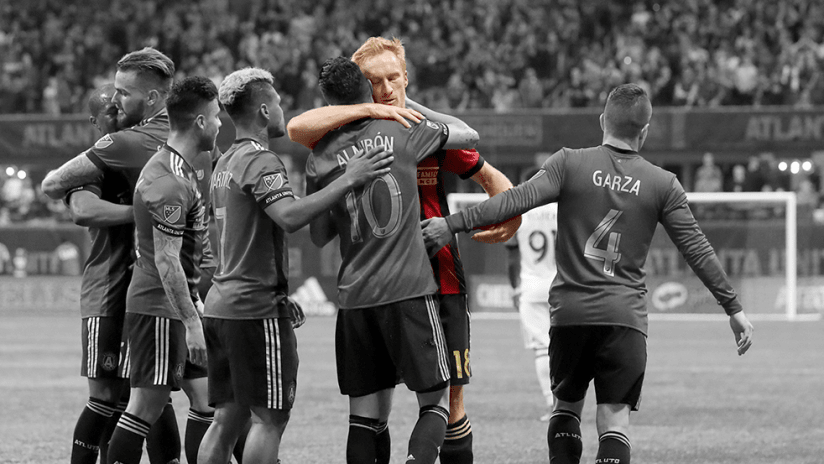Sometimes you've just gotta accept it’s better to do less.
In Week 1, Atlanta United got clobbered by the Houston Dynamo. Houston didn’t have to work particularly hard, either. You couldn’t have blamed any Atlanta fans for hitting the panic button.
In Week 2, Gerardo "Tata" Martino didn’t hesitate to switch things up. He maneuvered Atlanta’s starting formation from a 4-2-3-1 to a 3-5-2, and – more importantly – he moved Jeff Larentowicz back to the veteran’s more natural central midfield position. Larentowicz partnered with Darlington Nagbe and Miguel Almiron and took the more defensive role in the trio. Atlanta cruised by D.C. United, and looked everything we hoped they would prior to the season in a 3-1 victory. The switch to three in the back certainly helped Atlanta, but the bigger influence came from Larentowicz’s presence in the midfield.
On Sunday, Larentowicz did a very small, largely unnoticed act very well, and it changed the overall makeup of Atlanta's afternoon.
When Atlanta was in possession, Larentowicz held his positioning in the middle of the field. He didn’t move to try to find the ball – rather, he stood still. He asked for the ball when the option presented itself, and accepted passes when he was the right option for a teammate, but when he didn’t have a lane to receive a pass, he didn’t move to find a new one. He stayed central and protected the space in front of Atlanta’s most central defender, Michael Parkhurst.
Almost every time Atlanta got into a comfortable rhythm in possession in the middle third or D.C.’s half, as you can see in the following pictures, you knew where you would find Jeff Larentowicz: centrally located, tagging the nearest opponent.
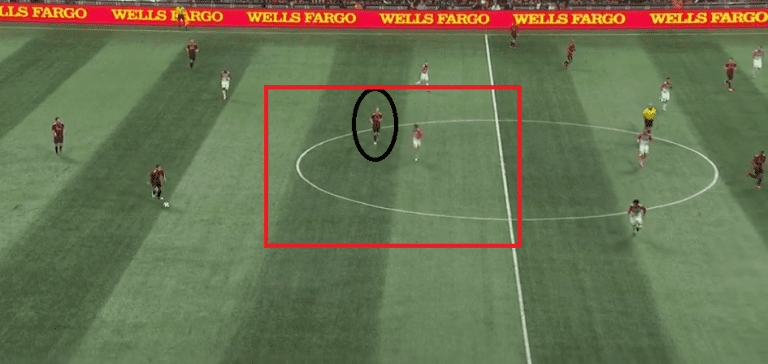
Jeff Larentowicz (circled) camping out as Atlanta begins to attack.
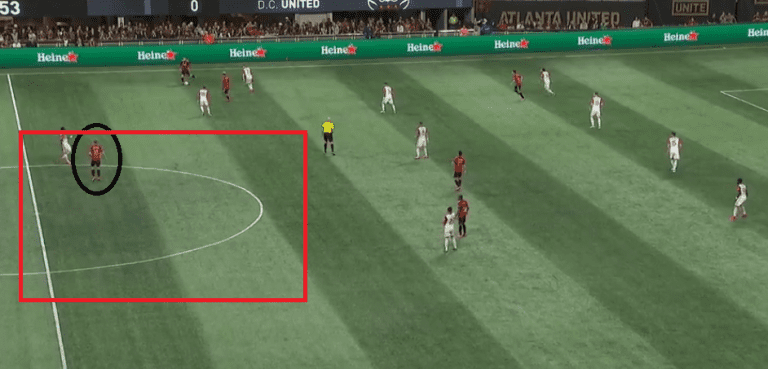
Larentowicz holding his position as Atlanta seek an opening.
Even when Larentowicz had a clear pocket to find the ball, he declined. In the play shown below, he could have moved forward five yards and been open for a pass from Nagbe, but he resisted.
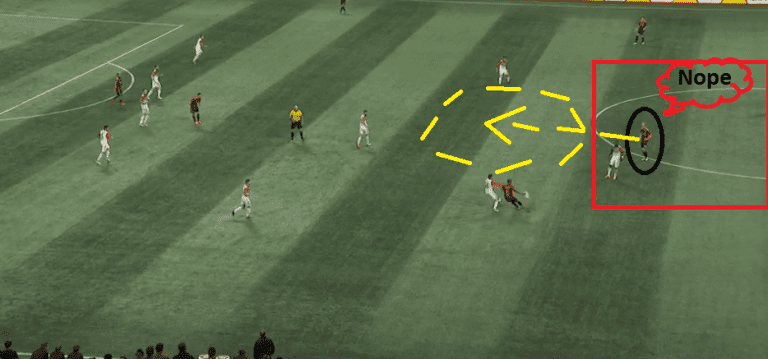
Larentowicz showing impressive discipline as the attack develops.
On Opening Weekend, Atlanta’s midfield pairing of Chris McCann and Darlington Nagbe worked hard to find the ball. They kept darting and shifting to create lanes for their teammates. You can’t blame them; Atlanta wants to be a passing team and center midfielders generally drive possession. McCann, as the more defensive of the pair, didn’t necessarily do anything wrong. It simply didn’t work.
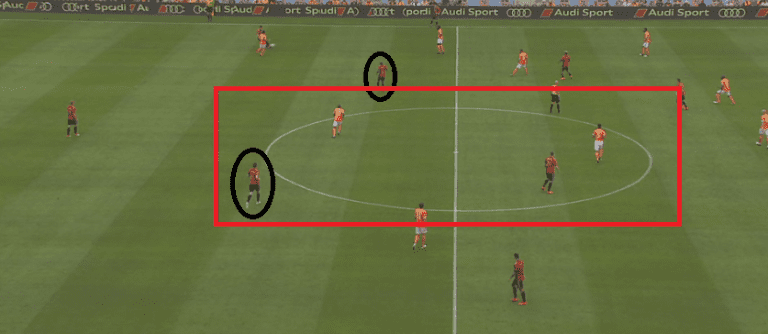
Chris McCann (circled, left) and Darlington Nagbe shift toward the ball to create a lane.
It’s not to say Larentowicz didn’t want the ball – all central midfielders want the ball. He simply had bigger fish to fry. We shouldn’t mistake lack of activity for inaction. Getting on the ball isn’t his role.
Sometimes a defensive midfielder doing less can free up the rest of the team to do more. In holding a central position, Larentowicz accomplished three goals:
- He protected the defense in transition moments.
- He was in position to win the ball back quickly and restart attacks.
- His predictable stability afforded other players more creative freedom in the attack.
It’s easiest to score in the moments just after a turnover because the defending team remains set up in an attacking posture. It’s nearly impossible to avoid giving the ball away, so you can only hope to mitigate the damage when it happens. It’s important to have more defenders back than the opposition has attackers going forward, and it’s important to protect the areas of the field that are the easier to score from. If you’re down numbers or vulnerable in key areas, you’re in trouble.
With Larentowicz often perched right in front of the Atlanta defense, he covered both areas of need. As a result, D.C. never looked to be a threat on the counter.
The second point is more interesting and more intricate. If we look at all of the photos again, there’s another note beyond Larentowicz’s general positioning on the field: He’s right next to a D.C. attacker. If D.C. wins the ball, where are they going to go?
Not anywhere. And Larentowicz already has his counter press set up to win the ball back immediately, flipping a potentially dangerous moment into an advantage.
With all this focus on defense, it might seem Larentowicz wasn't contributing to the attack. But when you realize how efficient he was at both winning the ball back and scooping up second balls, it becomes more clear that he was actually crucial to Atlanta’s attacking play.
The final piece is something we often misunderstand about defensive midfielders in the attack. In focusing forward, we can bemoan players who don’t show the “courage” or “intelligence” to run or pass ahead, rather accepting them as a necessary evil because they are important to the defensive phase of the game. It’s a mindset that completely ignores the overall makeup of a team.
Having a disciplined, predictable defensive midfield allows every other player on the field to be more creative. The attacking potential intensifies when the attacking midfielder … and wingers … and outside backs each know that they have a stable core behind them, protecting the most dangerous parts of the field covering other areas when needed.
They don’t have to allocate whatever percentage of their minds and movement that would normally be committed to additional defensive duties. One smart, disciplined defensive midfielde – even if he doesn’t attack once – can improve a team’s entire offense.
We saw that Sunday. Atlanta looked much better in Week 2 than the week prior, and it wasn’t luck. For all the excitement and flash, it was a small, simple adjustment from an ol' reliable veteran d-mid that made the difference.


